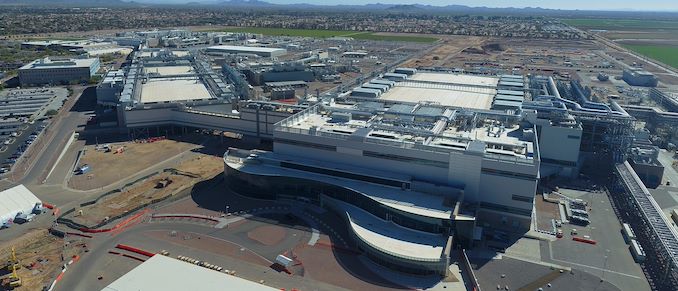Intel Accelerated Webcast on July 26th: Update on Process Technology and Roadmaps
by Dr. Ian Cutress on July 12, 2021 10:51 AM EST- Posted in
- CPUs
- Intel
- GPUs
- 10nm
- 7nm
- Packaging
- 3D Packaging
- IFS
- Intel Foundry Services
_678x452.jpg)
Earlier this year, new Intel CEO Pat Gelsinger outlined his new ‘IDM 2.0’ vision for Intel. This vision was a three-pronged strategy based on improving its own process node technology, mixing in other foundry technology where needed, and also realigning its manufacturing for a new foundry service offering allowing other semiconductor companies to use Intel’s manufacturing expertise. As part of the journey towards Gelsinger’s IDM 2.0 vision, we were told to expect updates at a more regular cadence, and the announcement of ‘Intel Accelerated’ in a couple of weeks is the next event on the calendar.
Intel IDM 2.0
As AnandTech reported back in March, Intel’s IDM 2.0 strategy features the following:
- Build (on Intel 7nm)
- Expand (use TSMC and others)
- Productize (Intel Foundry Services)
Previously Intel was almost completely insular, preferring to use its own technologies almost exclusively, and it kept them to itself. Through IDM 2.0, CEO Pat Gelsinger is hoping to drive Intel’s next wave of products by using the best the market has to offer, but also expand Intel’s own manufacturing to new customers as a potential revenue stream. The guise of this development is also in the sense of aligning semiconductor manufacturing outside of Asia, to make other areas of the world less reliant on a single resource.
Part of this strategy requires Intel to execute on its research roadmaps. Intel’s struggles to enable 10nm in suitably high volumes have been the focus of plenty of column inches, and while Intel is now shipping 10nm Tiger Lake-H in the millions* and 10nm Ice Lake Xeons in the hundreds of thousands*, there is a need to address the future of Intel’s manufacturing. This means making sure it aligns with commercial interests and enables a competitive offering against the competition. This covers not only manufacturing, to which Intel announced a $20b investment in its Arizona manufacturing earlier this year, but also advanced packaging technologies, where Intel announced a $3.5b investment in its New Mexico facilities in May.

Intel's Ocotillo Campus, Arizona
Part of creating its Intel Foundry Services offering for external parties to use Intel manufacturing relies on Intel being more open about its technology and showcasing progress in its research and development, perhaps to a degree more than it has done in the past. Any future customers of Intel’s IP portfolio will want to know what is coming down the pipe, especially when silicon development takes years and getting the right timing in the alignment of technologies becomes very important in these competitive markets. Having a platform to showcase Intel’s roadmaps is what this upcoming Intel Accelerated Webcast seems to be about.
Intel Accelerated
On Monday July 26th, 2pm Pacific, Intel will livestream its Intel Accelerated webcast. The topics of the day are presentations from CEO Pat Gelsinger and Dr. Ann Kelleher on Intel’s process node technology development and roadmaps into Intel’s packaging portfolio. Dr. Ann Kelleher is Intel’s SVP and GM of Technology Development, and the person in charge of all of this.
We are hoping that this webcast will go into detail as to where Intel expects its 10nm development to go on SuperFin/Enhanced SuperFin, leading into discussions about 7nm. While Intel won’t be discussing things like buried power rails or new manufacturing techniques, we will hopefully see a disclosure more akin to TSMC and Samsung’s Foundry events that happen yearly regarding what variations of process node development are being targeted.
On the packaging front, we know that Intel has EMIB, Foveros, and ODI under research up against TSMC’s 3DFabric, so insights into how Intel is developing its technology will be welcome by both the semiconductor industry but also the financial markets. Interestingly enough, while this event is on the 26th, Intel’s quarterly financial disclosures are on the 22nd, a few days prior. On Intel’s packaging, as the company moves into its Client 2.0 strategy of drilling everything down into silicon IP blocks, understanding exactly how those will all be connected becomes a vital element to the future of Intel.
The event will be open to all on Intel’s Newsroom.











28 Comments
View All Comments
ikjadoon - Monday, July 12, 2021 - link
Do the asterisks mean to point to a footnote?Ian Cutress - Monday, July 12, 2021 - link
It was meant to be a line defining Dr. Kelleher's role, but I ended up integrating it into the paragraph anyhow.dullard - Monday, July 12, 2021 - link
Ian, you corrected 1 of the 3 missing footnotes.ikjadoon - Monday, July 12, 2021 - link
Let’s see what they deliver. If we look in Intel’a history, IDM 2.0 isn’t too new. Just “old strategies, but now with vigor!”It doesn’t solve Intel’s management culture woes, its market arrogance (that will always bite any new initiative until it’s weak), and its utter lack of consumer understanding on mobile / thin-clients.
Foundry Services is just a rebrand of a decade-old failure. Intel has been looking for foundry customers (both with in-house and custom IP, including IA!) and they’re always claiming they’re doing great. Intel’s CFO was bragging to Reuters in 2011,
> Understandably, Smith would prefer to provide his customers with Intel-designed cores. "If Apple or Sony came to us and said 'I want to do a product that involves your IA core and put some of my IP around it', I wouldn't blink. That would be fantastic business for us," he said.
> But he wasn't as firm as Otellini when it came to non-IA cores. "Then you get into the middle ground of 'I don't want it to be an IA core, I want it to be my own custom-designed core,' and then you are only getting the manufacturing margin, [and] that would be a much more in-depth discussion and analysis," he told journos after the UK investor event.
https://www.theregister.com/2011/05/27/stacy_smith...
Nothing new. Same-old strategy, nearly the same people, same corporate code problems.
Even RISC-V isn’t new; Intel has known for decades that its x86 designs have inherent baggage and will not work everywhere, especially in power constrained environments.
Intel repeatedly tried to pivot to Arm in the 1990s and they still hold an Arm v6 arch license. It’s literally the 1990s and early 2000s in Intel.
The RISC-V deal is again just…so what? Intel literally owned StrongARM, one of the highest performing Arm CPUs of the day, and flailed with XScale, selling it off and killing the division. StrongARM was developed by Dan Dobberpuhl, who promptly left once Intel took over.
Where did Dan go? Founded PA Semi and then went to Apple. 😂
Intel doesn’t care about anything but its own x86 cores. Trying to make IFS succeed while maintaining that “we’re a neutral foundry! We won’t steal your designs and you have the Intel Promise” sounds just not enticing.
Any IP firm that goes to IFS today is making an enormous risk and it is not only node timelines.
JayNor - Monday, July 12, 2021 - link
There was a story here on an Intel 7nm risc-v project for 2022. Doesn't fit the "doesn't care about anything but its own x86" theme.ikjadoon - Monday, July 12, 2021 - link
It's less exciting than it seems.The latest node: Lakefield, Celeron, Pentium, Atom and Core-Y are also fabricated on the newest nodes. None are able to supplant the primary Core U / H / S / K / X CPUs. :-/
Intel foundries building non-x86 CPUs: It's been done before in the late 1990s / early 200s, for the exact same reasons, and it flopped so hard, Intel had to sell the unit off to Marvell.
— 1997: Intel "acquires" StrongARM, a RISC CPU IP firm, for $700m ($1.2b in 2021 dollars)
— 1997 to 2006: Intel fabricates the newly-acquired Arm-based CPUs at Intel foundries, up to 45nm (PXA935)
— 2006: Intel, having done incredibly poorly and floundering a once-cutting-edge Arm team, sells the XScale's PXA division to Marvell for $600m + liabilities
You can still read Intel's old press releases on their site, which is wild to me:
https://www.intel.com/pressroom/archive/releases/1...
https://www.intel.com/pressroom/archive/releases/2...
"The Intel® StrongARM® SA-1110 Microprocessor (SA-1110) is a highly integrated communications microcontroller that incorporates a 32-bit StrongARM® RISC processor core, system support logic, multiple communication channels, an LCD controller, a memory and PCMCIA controller, and general-purpose I/O ports."
These are genuinely ancient strategies. Buy StrongARM in 1997, buy RISC-V in 2021. Think they are "too weak" compared to your big cores, so you refuse to grow their market each year like everyone else (and how your own x86 CPU teams do). Figure out that it's simply losing money compared to all other competitors, so you cut your losses and proclaim, "IDM 3.0 is coming soon.... Intel acquires Qualcomm!" /s
serendip - Tuesday, July 13, 2021 - link
Intel needs to do something with mixed cores like Lakefield or ARM big.LITTLE without the hype.lemurbutton - Monday, July 12, 2021 - link
Reports are that Intel and Apple will be TSMC's biggest 3nm customers. Sell AMD stocks if you have any.Silver5urfer - Monday, July 12, 2021 - link
LMAO, their Sapphire Rapids on 10nmSF which is going to take on Milan is not even out, which is where real money is at. And the Tiger Lake is another source of their money, but DC market is what kept Intel alive.TSMC 3nm is too far away and we do not even know what processors they would be making, on top of that, Intel making a TSMC based silicon that is gen1 is going to be trash no question, a completely new set of manufacturing process for Intel since how many years ? It never happened.
That said, what are those CPUs ? Server processors which are Xeon based or the Laptop silicon ? Since Biglittle Intel, the Silicon will be made different unlike the usual XCC / HCC lineup that Intel has been doing since decades. Because there's no Server x86 processor which is going to be made like this, they won't be wasting the die space on Server sockets with that sort of joke of power saving BS. Esp when AMD Zen 4 is pegged at 80+ Physical x86 cores.
Intel is only going to play safe game, TSMC Tech for their CPUs and trying to beat AMD in contracts, until they can answer to Milan Intel is nothing but a corporate Goliath only fit for corruption.
JayNor - Monday, July 12, 2021 - link
Sapphire Rapids is 10esf. broadly sampling since Dec 2020.